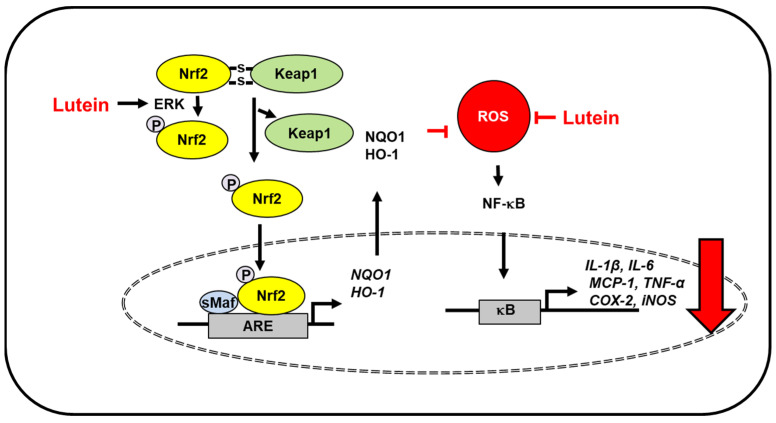Figure 1.
The proposed mechanism by which lutein inhibits oxidative stress-induced inflammatory responses in the brain. ROS levels increase in severe traumatic brain injury and lipopolysaccharide-activated microglia. Lutein reduces ROS levels and inhibits ROS-mediated activation of NF-kB and expression of inflammatory mediators (IL-1β, IL-6, MCP-1, TNF-α, COX-2, iNOS) [37]. In lipopolysaccharide-activated microglia, lutein activates ERK, which phosphorylates Nrf2 and increases dissociation of Keap1 from the Nfr2/Keap1 complex. Thus, it promotes nuclear translocation of Nrf2, which forms a heterodimer with sMaf protein and binds to a regulatory region of DNA called ARE. It induces the expression of Nrf2- target antioxidant genes (HO-1, NQO1). These antioxidant enzymes reduce intracellular ROS levels, which suppresses inflammatory responses [38]. Thus, lutein prevents oxidative stress-mediated neuroinflammation. ARE, antioxidant response element; COX-2, cyclooxygenase-2; ERK, extracellular signal-regulated kinase; HO-1, hemeoxygenase-1; iNOS, inducible nitric oxide synthase; IL, interleukin; Keap1, kelch like ECH associated protein 1; MCP-1; monocyte chemoattratant protein-1; NF−κB, nuclear factor-κB; Nrf2, nuclear factor erythroid 2–related factor 2; NQO-1, NAD(P)H: quinone oxidoreductase 1; ROS, reactive oxygen species; sMaf, small Maf; TNF-α, tumor necrosis factor-α.

